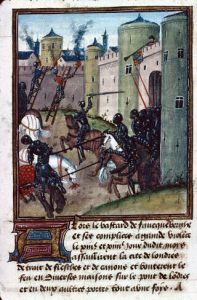Sieges – a Timeline
Whilst the Wars of the Roses is better known for the battles that took place, there were Sieges of note during the conflict. These were not perhaps as large, brutal, or significant as some of those that had taken place in the Hundred Years War. Nor were they as frequent, or consequential, as those of the civil wars of the Seventeenth Century. However, these sieges impacted upon the military and political fortunes of the Lancastrian and Yorkist factions during the period, drawing in manpower, armaments, supplies, and having a psychological and political impact on the course of the conflict.
Several of the Sieges of the Wars of the Roses are reasonably well known. Harlech in north Wales is remembered as having been the longest Siege to have taken place in the British Isles. St. Michael’s Mount was seized, then besieged, and is reasonably well known. That London, or the Tower of London, was besieged is regularly noted in social media groups, and had a clear impact on events of 1460 and 1471. Castles in the north east are notable in their role as a haven for the Lancastrians in the period 1461-1464. These, however, are only some of the sieges that occured during the era of the Wars of the Roses.
Timeline of Sieges in the Wars of the Roses
1455
Berwick-upon-Tweed. Brief siege of Berwick by the Scots. The siege was lifted upon the approach of an English relief force.
November – December
Powderham. The Earl of Devon, Thomas Courtenay, besieged the castle until the intervention of forces sent by Richard 3rd Duke of York (as Protector).
1456
Summer
Carmathen. This siege resulted in the capture, imprisonment, and eventual death in captivity of Edmund Tudor Earl of Richmond. The Yorkist force that captured the castle was led by Sirs William Herbert and Walter Devereux.
1459
August into 1461
Calais. Henry Beaufort Duke of Somerset was appointed as Captain of Calais as a result of the Yorkist flight from Ludford Bridge and the subsequent Parliament of Devils at Coventry. He attempted to seize control of the port through force of arms from late 1459 into 1460. The Yorkists held off the Lancastrian attacks and were able to mount their own cross channel raid on Sandwich whilst being besieged. Within the Pale of Calais the fortresses at Guines and Hammes were both subjected to Siege at this time. Guines from 5 August 1460 to 9 January 1460. Hammes surrendered to the Yorkists on 24 October 1461. Thank you to Dr. David Grummitt for dates on Guines and Hammes.
1460
February – March
Denbigh. Taken from Yorkists by Jasper Tudor Earl of Pembroke.
July
Tower of London. Yorkist forces besieged the Tower of London from 2/3 July until the surrender of the Lancastrian garrison, on terms, on 19 July 1460.
December – June 1461
Carisbrooke. A Lancastrian garrison commanded by Edmund Beaufort, future Duke of Somerset, was besieged by a Yorkist force. Details are unclear as to the nature of the fall of Carisbrooke Castle, but it was in Yorkist hands in June 1461 and Edmund Beaufort was taken into captivity.

1461
March – April
Thorpe Waterville. Sir John Wenlock besieged Thorpe Waterville through March, with the Lancastrian garrison surrendering on 4 April 1461.
May
Skipton. The seat of the Clifford family, staunch Lancastrians, fell to the Lancastrians by the end of May 1461.
Mont Orgueil Castle. Mont Orgueil, also known as Gorey Castle, is on the Channel Island of Jersey. It fell in May 1461 to Frenh forces commanded by Queen Margaret’s cousing, Pierre de Brézé, in circumstances that suggest the betrayal of the site to Margaret’s sympathisers.
May – June (Date unclear)
Carlisle. Whilst details are unclear, it is known that Carlisle Castle fell to the Yorkists in May or June of 1461.
June
Carlisle. Following the Yorkists seizing the Castle at Carlisle, the Scots besieged the Castle and Town of Carlisle. The besiegers were routed by a relief force commanded by John Neville Lord Montagu.
August
Chirk. The castle was besieged by Yorkist forces under Sir William Stanley, who seized the castle.
October – August 1468
Harlech. Following the Battle of Twt Hill the castles of north Wales fell or surrendered in quick succession. Except Harlech. Harlech held out for the Lancastrians until August of 1468. Whilst the siege was not particularly violent most of the time, it was surrounded and as such this is the longest Siege to have taken place in the British Isles.
November
Rhuddlan. Lancastrian forces held out for 13 days before surrendering to a Yorkist force commanded by Sir William Stanley.
Late 1461
Conway. Petitions found by Dr Dan Spencer in his research show that Conway Castle was taken for the Yorkists through use of force by Sir Robert Bold late in 1461.

1462
July
Kirkoswald. Fell to the Yorkists following a brief siege.
Naworth. Sir Humphrey Dacre surrendered on terms to a force commanded by John Neville Lord Montagu in July 1462.
July – August
Alnwick. Held by the Lancastrians under Sir William Tailboys. Besieged by Yorkists commanded by William Lord Hastings and Sir Ralph Grey. The Lancastrians surrendered in either late July or early August.
October – November
Alnwick. The Yorkist garrison that had been established in the summer of 1462 was forced to surrender to besieging Lancastrian forces due to a lack of provisions.
December
Bamburgh. A short siege saw Yorkist forces led by John Neville Lord Montagu and Robert Lord Ogle secure the surrender, on terms, of the Lancastrian garrison. The Lancastrian force was headed by Henry Beaufort Duke of Somerset, Jasper Tudor Earl of Pembroke, Thomas Lord Roos, and Sir Ralph Percy.
Dunstanburgh. Simultaneous to the siege of Bamburgh. Dunstanburgh surrendered on 27 December to a Yorkist force commanded by John Tiptoft Earl of Worcester and Sir Ralph Grey.
December into January 1463
Alnwick. The Yorkists responded to the fall of Alnwick in November by assembling a force under William Neville Earl of Kent and Anthony Woodville Lord Scales. Some of the Lancastrian defenders escaped on 5 January 1463, with the remainder of the garrison surrendering soon afterwards.

1463
Skipton. In late 1463 into early 1464 Skipton Castle was besieged, successfully, by Lancastrian forces.
1464
Skipton. Thomas Lord Stanley and his brother Sir William Stanley led a response to the Lancastrians seizing Skipton Castle (see above). The castle fell to the pair in Spring of 1464.
Summer 1464
Bamburgh. Richard Neville Earl of Warwick and his brother John, at this point the Earl of Northumberland, lay siege to Bamburgh, taking it by use of force. The Lancastrian garrison was commanded by Sir Ralph Grey.
1468
‘Early’
Mont Orguell Castle, Jersey. Retaken from French supporters of the Lancastrians by a force commanded by Yorkist Richard Harliston. This followed a siege said to have been some 19 weeks in duration.
August
Fall of Harlech. See October 1461.
1469
21 August – 27 September
Caister Castle. John Mowbray Duke of Norfolk, lay siege to Caister which was held by the Paston Family under John Paston. The Paston’s surrendered on terms on 27 September 1469.

1470
Carlisle. Forces loyal to Edward IV besieged the castle which was held by men loyal to Richard Neville Earl of Warwick. The castle fell, though it is not known whether this was through negotiation, or by force.
1471
Pembroke. Failed siege by Yorkists under Morgan ap Thomas. The castle was held by Jasper Tudor Earl of Pembroke. The siege failed as a result of a military intervention on Tudor’s behalf by David ap Thomas, the brother of Morgan who was laying siege to the castle.
May
London. Thomas Neville bastard of Fauconberg led a Lancastrian assault on London from land and the River Thames. This included bombardment of the Tower of London from the River.

1473
October – 15 February 1474
St. Michael’s Mount. John de Vere Earl of Oxford seized St. Michael’s Mount in late October 1473. It was subsequently besieged by forces dispatched by King Edward IV. These were led by Sir John Arundell, Henry Bodrugan, and John Fortescu. The Earl of Oxford and other defenders surrendered on terms on 15 February of 1474. The Earl was then placed in captivity, until his escape from Guisnes in the reign of Richard III.
1482
July – August
Berwick-upon-Tweed. As Richard Duke of Gloucester led the invasion of Scotland a force was left to lay siege to Berwick. The siege resulted in the surrender of the Scottish holders, on terms, in August. Berwick-upon-Tweed has remained in English hands ever since.
Recommended Book

